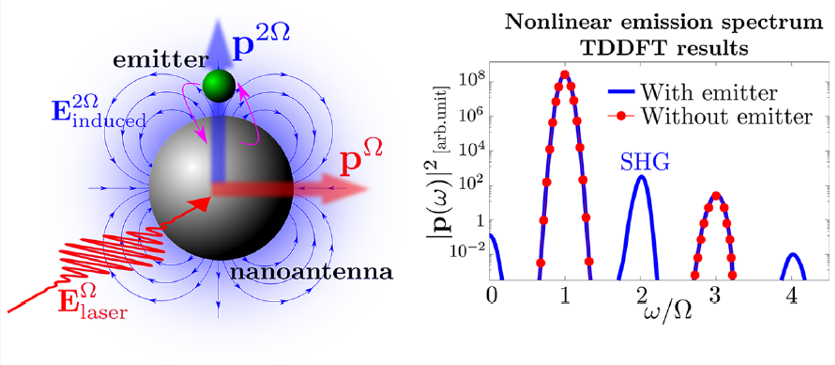Second-harmonic generation in a quantum emitter – metallic nanoparticle hybrid
When two photons with the same energy interact with a nonlinear material, they “combine” and generate a new photon with twice the energy of the initial photons. More precisely, two photons at the fundamental frequency are absorbed by a plasmonic structure to emit one photon at the second-harmonic frequency. This is called second-harmonic generation.
Second-harmonic generation is a nonlinear response very sensitive to the geometry of the system. Actually, second-harmonic generation is not possible for centro-symmetric materials and nanostructures. But, as geometry must be understood broadly, we must also consider surface effects that may eventually break the structural symmetry constraints, leading to the emission of light at the second harmonic in systems where it was not supposed to be possible.

Now, a team of researchers have studied 1 the second-harmonic generation resulting from a hybrid system consisting of a quantum emitter (such as an organic molecule or a quantum dot) placed in the vicinity of a spherical metallic nanoparticle. They find that, even though the small individual centro-symmetric nanoparticle does not allow for second-harmonic emission, the presence of the quantum emitter lifts this symmetry constraint.
To calculate the nonlinear response of the coupled system and to reveal the physical mechanisms behind the second-harmonic generation in this situation, the researchers use a quantum approach based on the time-dependent density functional theory.
They find that, when the electronic transition frequency of the quantum emitter is resonant with the second harmonic of the incident frequency, the quantum emitter plays the role of an optical resonator, which efficiently couples to the nonlinear near fields induced around the nanoparticle, extracting them to the far field and thus producing second-harmonic generation. This metallic nanoparticle-quantum emitter system thus enhances the frequency conversion and allows for its control.
Using these insights, the researchers built a semiclassical model that naturally incorporates the losses and the plasmon decay. This model not only reproduces the outcome of the quantum calculations, but also makes possible a detailed study of the sensitivity of the second-harmonic generation to different parameters that characterize the system.
Although the results are obtained for a model spherical nanoparticle and a structureless quantum emitter, they clearly show that the hybrid metallic nanoparticle-quantum emitter structure can be a promising platform for enhancing second-harmonic generation and probing the nonlinear near fields of metallic nanostructures.
Author: César Tomé López is a science writer and the editor of Mapping Ignorance
Disclaimer: Parts of this article may be copied verbatim or almost verbatim from the referenced research paper.
References
- Antton Babaze, Ruben Esteban, Javier Aizpurua, Andrei G. Borisov (2020) Second-Harmonic Generation from a Quantum Emitter Coupled to a Metallic Nanoantenna ACS Photonics doi: 10.1021/acsphotonics.9b01569 ↩